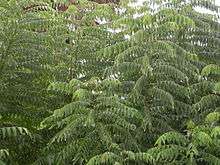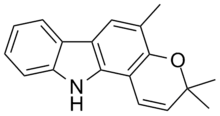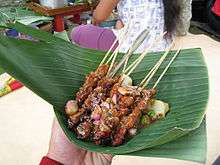Curry tree
| Curry tree | |
|---|---|
 | |
| Scientific classification | |
| Kingdom: | Plantae |
| (unranked): | Angiosperms |
| (unranked): | Eudicots |
| (unranked): | Rosids |
| Order: | Sapindales |
| Family: | Rutaceae |
| Genus: | Murraya |
| Species: | M. koenigii |
| Binomial name | |
| Murraya koenigii | |
The curry tree (Murraya koenigii) is a tropical to sub-tropical tree in the family Rutaceae (the rue family, which includes rue, citrus, and satinwood), which is native to India and Sri Lanka.
Its leaves are used in many dishes in India, Sri Lanka, and neighbouring countries. Often used in curries, the leaves are generally called by the name 'curry leaves', although they are also literally 'sweet neem leaves' in most Indian languages (as opposed to ordinary neem leaves which are very bitter and in the family Meliaceae, not Rutaceae).
Description

It is a small tree, growing 4–6 m (13–20 feet) tall, with a trunk up to 40 cm (16 in) diameter. The aromatic leaves are pinnate, with 11–21 leaflets, each leaflet 2–4 cm (0.79–1.57 in) long and 1–2 cm (0.39–0.79 in) broad. The plant produces small white flowers which can self-pollinate to produce small shiny-black drupes containing a single, large viable seed. Though the berry pulp is edible—with a sweet but medicinal flavour—in general, neither the pulp nor seed is used for culinary purposes.[2]
The species name commemorates the botanist Johann König. The genus Murray commemorates Swedish physician and botanist Johan Andreas Murray who died in 1791. [2]
Uses
The leaves are valued as seasoning in southern and west-coast Indian cooking, and Sri Lankan cooking, usually fried along with vegetable oil, mustard seeds and chopped onions in the first stage of the preparation. They are also used to make thoran, vada, rasam and kadhi. They are also available dried, though the aroma is largely inferior.
The leaves of Murraya koenigii are also used as an herb in Ayurvedic and Siddha medicine in which they are believed to possess anti-diabetic properties,[3] but there is no high-quality scientific evidence for such effects. In the absence of tulsi leaves, curry leaves are used for rituals, such as pujas.
Propagation
Seeds must be ripe and fresh to plant; dried or shriveled fruits are not viable. One can plant the whole fruit, but it is best to remove the pulp before planting in potting mix that is kept moist but not wet.
Stem cuttings can be also used for propagation.
Chemical constituents

Compounds found in curry tree leaves, stems, bark, and seeds contain cinnamaldehyde,[4] and numerous carbazole alkaloids, including mahanimbine[5] and girinimbine.[6]
References
- ↑ "Murraya koenigii". Germplasm Resources Information Network (GRIN). Agricultural Research Service (ARS), United States Department of Agriculture (USDA).
- 1 2 Henry, Trimen (1893). A hand-book to the flora of Ceylon. London: Dulau & Co. p. 219. Retrieved 1 August 2015.
- ↑ Rashmee Z Ahmed (30 September 2004). "Traditional diabetes remedy offers hope". The Times Of India.
- ↑ Sankar Ganesh, Ravishankar Rai; et al. (2015). "In vitro antibiofilm activity of Murraya koenigii essential oil extracted using supercritical fluid CO2 method against Pseudomonas aeruginosa PAO1". Natural Product Research. 29 (24): 2295:2298. doi:10.1080/14786419.2015.1004673. ISSN 1478-6427.
- ↑ "Mahanimbine". PubChem. 2017.
- ↑ "Girinimbine". PubChem. 2017.
External links
| Wikimedia Commons has media related to Murraya koenigii. |
